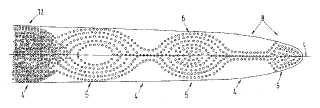Endodontic pin for introducing into a curved root canal with a single-piece base body, comprises a plastic matrix, which is reinforced with fibers that are embedded parallel to a longitudinal axis in
The endodontic pin for introducing into a curved root canal with a single-piece base body (1), comprises a plastic matrix (2), which is reinforced with fibers (3) that are embedded parallel to a longitudinal axis in the plastic matrix. The base body has zones with different flexural and torsional strengths, where one zone has a reduced flexural and torsional strength. The plastic matrix reinforced with the fibers contains different concentrations of reflection-/absorption particles over a length and a cross-section of the base body for reflecting and absorbing a laser beam (11). The endodontic pin for introducing into a curved root canal with a single-piece base body (1), comprises a plastic matrix (2), which is reinforced with fibers (3) that are embedded parallel to a longitudinal axis in the plastic matrix. The base body has zones with different flexural and torsional strengths, where one zone has a reduced flexural and torsional strength. The plastic matrix reinforced with the fibers contains different concentrations of reflection-/absorption particles over a length and a cross-section of the base body for reflecting and absorbing a laser beam (11), so that the different bending and torsional stiffnesses are obtained. A higher portion of the reflection-/absorption particles is contained in one zone having high flexural and torsional strength than in one zone having reduced flexural and torsional strength. The outer surfaces of the pin have displacement elements in the form of channels and/or grooves. The displacement elements axially or arcuately run to the longitudinal axis. The reflection-/absorption particles are contained in a concentration of 1-90 wt.%, and have a diameter of 10-100 nm. The reinforced fibers are organic and/or mineralized fibers, which are contained in a concentration of 50-90 wt.%. The endodontic pin has a filler material, which is contained in the plastic matrix with a portion of 50-90 wt.%. The base body has two zones with increased flexural and torsional strength in dependent of its lengths, a conically running distal tip area (8), in which externally-lying fiber ends are remelted from the plastic matrix and which has a structure module of 3-15 GPa, a proximal end, which has a structure module of 15-50 GPa, and a constriction. An independent claim is included for a method for producing an endodontic pin.Attached files:

Patents:
DE 102,008,042,021
Inventor(s): SCHMIDT WOLFRAM [DE]; SCHMITZ KLAUS-PETER [DE]; BEHREND DETLEF [DE]; STERNBERG KATRIN [DE]
Type of Offer: Sale
« More Dental Patents
